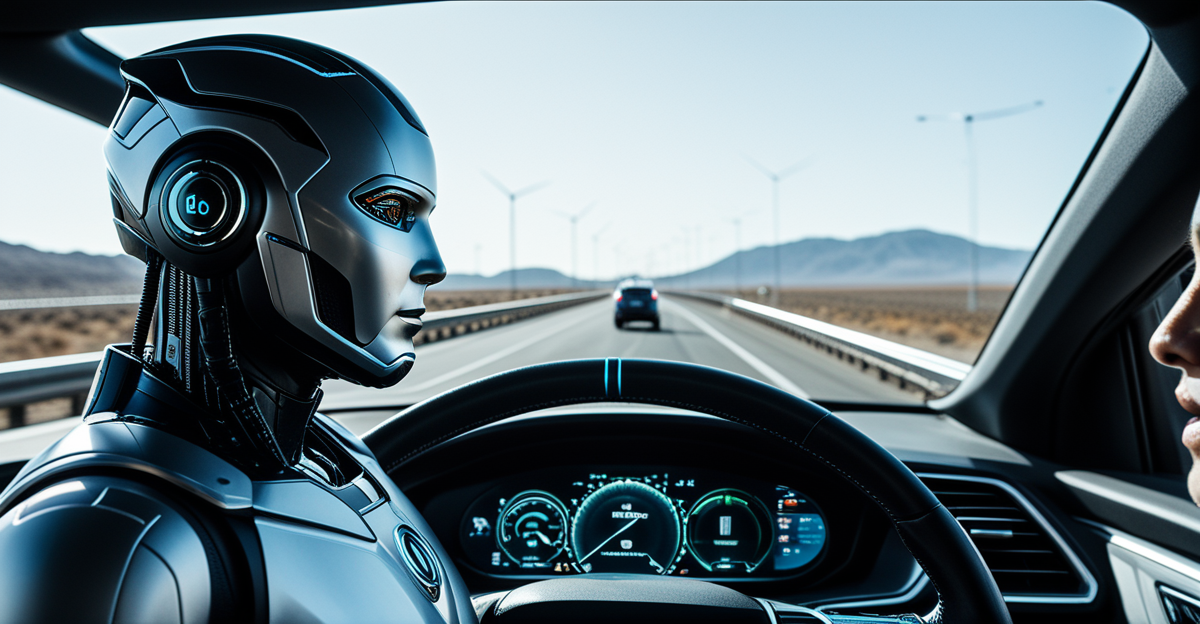Overview of AI in Transportation
Artificial Intelligence (AI) is rapidly transforming the transportation sector, shaping the future of how people and goods move from place to place. AI in transportation plays a crucial role by enhancing efficiency, safety, and convenience. The integration of AI into current transportation systems offers several advantages, including optimised traffic flow, reduced accident rates, and improved logistics operations. As the demand for smarter transport solutions grows, the timeline of AI adoption in the transportation sector is accelerating towards widespread implementation.
One of the most significant impacts of AI is seen in the development of future transport technology, where intelligent systems predict maintenance needs and provide real-time data analytics for operational improvement. By automating routine processes, AI reduces costs and environmental impact, supporting sustainable transportation practices.
Also to read : How Can UK Technology Companies Adapt to a Post-Brexit Economy?
Looking forward, the focus on AI technologies will likely influence regulatory frameworks and transport policies, ensuring that future advancements in transport technology are not only innovative but also equitable and environmentally conscious.
Autonomous Vehicles and AI
Autonomous vehicles are at the forefront of self-driving technology, a transformative innovation within AI-driven transport systems. These technologies utilize AI driving systems to navigate and control vehicles with minimal or no human intervention, promising a revolution in how we perceive and interact with transportation.
Also to see : How is the Evolution of AI Transforming UK Industries?
Current State of Autonomous Vehicle Development
The development of autonomous vehicles is progressing rapidly, with numerous companies trialling AI driving systems. These systems combine sensors, cameras, and machine learning algorithms to interpret surroundings and make driving decisions. While fully autonomous cars are still maturing, semi-autonomous features like lane-keeping assistance and adaptive cruise control are becoming increasingly common in consumer vehicles.
Key Technologies Driving Autonomous Vehicles
Several key technologies underlie the success of self-driving systems. Lidar and radar provide detailed environmental mapping, while AI algorithms process this data to predict traffic patterns and obstacles. Integrating these elements ensures safe navigation and real-time decision-making, critical for autonomous vehicles’ functionality.
Real-World Implementation and Case Studies
In real-world settings, autonomous vehicles are being tested in controlled environments. Companies like Waymo and Tesla are leading the charge, deploying fleets of AI-driven cars for public trials. These case studies highlight the advantages of self-driving technology, particularly in enhancing road safety by reducing human error, which is responsible for the vast majority of traffic accidents. However, challenges such as urban infrastructure adaptation and weather conditions continue to pose obstacles to widespread implementation.
AI in Traffic Management Systems
Traffic management AI is revolutionizing the way urban areas address traffic congestion, optimizing the flow of vehicles and enhancing urban mobility. By utilizing smart algorithms and machine learning, AI-driven systems can anticipate traffic patterns and adjust in real-time to ensure smooth operations. This technology is particularly beneficial during peak hours when congestion typically reaches its zenith.
One of the most promising applications is smart traffic systems, which include intelligent traffic lights capable of autonomously adjusting their sequences based on real-time conditions. These lights communicate with each other to manage traffic efficiently, leading to decreased wait times and reduced fuel consumption. Cities implementing these systems report significant improvements in traffic management and reduced commuter frustration.
Several cities have adopted these smart traffic light systems with noticeable success. For instance, Los Angeles has integrated AI technology into its traffic management system, resulting in a significant decrease in congestion across the metropolitan area. Such case studies underscore the potential of AI in optimizing traffic flow, highlighting the transformative impact of these advancements on urban traffic management.
Environmental Impacts of AI in Transportation
The integration of AI in transportation has notable environmental implications, primarily through the promotion of sustainable transportation practices. By optimizing traffic and logistics, AI significantly reduces carbon emissions. Autonomous vehicles, a key innovation, contribute to eco-friendly transport solutions by minimizing fuel consumption and promoting efficiency in route planning. However, the adoption of these technologies raises concerns about balancing technological advancements with environmental sustainability.
AI-driven systems can forecast and adjust vehicle operations to ensure minimal energy usage, directly impacting air quality. The precision of AI in predicting demand and streamlining operations across the supply chain technology enhances overall efficiency. Additionally, initiatives leveraging AI aim to develop greener urban infrastructures, highlighting a future where technology and ecology coexist harmoniously.
Despite these benefits, it is crucial to consider the environmental cost of the production and disposal of AI components. The trade-offs between advancing emerging transport technologies and maintaining ecological integrity remain a pertinent discussion among policymakers and industry leaders. Nonetheless, AI continues to offer promising avenues for reducing the transportation sector’s carbon footprint.
Social Implications of AI in Transportation
The integration of AI in transportation brings about significant social impacts, influencing how individuals interact with transport systems and access services. As AI technologies advance, they offer the potential to enhance accessibility for all, including vulnerable populations, ensuring more equitable transport solutions.
Enhancing Accessibility through AI
AI-driven systems can greatly improve accessibility in transport by providing tailored solutions that cater to diverse needs. For instance, AI technology can support the development of user-friendly interfaces and real-time assistance for individuals with disabilities. Such innovations not only enhance the travel experience but also ensure that transportation systems are inclusive and accessible to everyone, regardless of their physical limitations.
Public Concerns and Perceptions about AI in Transport
Despite the benefits, there are public perception challenges associated with AI in transportation, primarily revolving around safety and privacy concerns. Many worry about the reliability of AI-driven systems and the potential loss of control over personal data. Addressing these concerns is critical, as public acceptance is pivotal to the successful deployment of AI technologies in transport. Efforts to educate the public about AI’s safety measures and data protection strategies can help alleviate these fears and foster a more accepting attitude toward AI in transportation.
Equity in Transportation Access with AI
AI applications have the potential to revolutionize equity in transportation access by ensuring that everyone, regardless of socio-economic status, can benefit from advanced transport solutions. Through AI, transport systems can be optimized to offer affordable and efficient services to underserved communities, bridging the gap in transport access. Policymakers and industry leaders must work together to ensure that AI-driven innovations in transportation are implemented equitably, fostering inclusivity and supporting social well-being.
AI in Logistics and Supply Chain Optimization
The incorporation of AI logistics is revolutionizing how supply chains operate, driving efficiency in transportation processes. AI applications in logistics help streamline operations, predicting maintenance needs, optimizing routing, and enhancing inventory management. By utilizing supply chain technology, businesses can achieve faster delivery times and cost reductions. AI systems analyze large datasets to improve decision-making and forecast demands, leading to more reliable and efficient supply chains.
AI Applications in Logistics
AI technologies in logistics encompass a range of applications, including predictive analytics, logistics automation, and route optimization. By leveraging AI logistics, companies can anticipate demand fluctuations and adjust operations accordingly, minimizing waste and maximizing resource use. The ability to automate tasks reduces manual errors and enhances the overall performance of supply chains.
Benefits of AI in the Supply Chain
The primary benefits of integrating AI into supply chains include enhanced accuracy in demand forecasting, reduced operational costs, and increased speed in delivery times. AI systems optimize warehouse operations, improve inventory management, and significantly cut down on waste through better resource allocation. These advantages position AI as a crucial driver of future efficiency in transportation and logistics.
Real-Life Examples of AI in Logistics
Companies are increasingly adopting AI-driven solutions to improve their supply chain operations. For example, DHL and Amazon have integrated supply chain technology to enhance their logistics efficiency. Such real-life implementations showcase the transformative potential of AI, reflecting its impact on reducing costs and improving delivery times. Despite these benefits, logistics companies must navigate challenges such as data privacy and system integration when adopting AI technologies.
Future Trends in AI and Transportation
As we look toward the future of AI transportation, it’s clear that emerging transport technologies will significantly transform how we travel and commute. Over the next decade, AI-driven transport solutions are expected to become more sophisticated and widely adopted, reshaping not only daily commutes but also global logistics.
Predictions for Future AI-Driven Transport Solutions
Future AI innovations in transportation are expected to prioritize safety and efficiency, with advancements in autonomous systems leading the charge. Predictive maintenance, real-time data analysis, and enhanced AI algorithms will likely minimize breakdowns and improve route optimization. Furthermore, self-driving technology should become more commonplace, transitioning from test phases into routine operations on public roads.
Role of Policy and Regulation
The success of future AI transportation heavily relies on robust policy frameworks and regulations. Governments are anticipated to play a crucial role in defining safety standards and data privacy measures, ensuring AI innovations do not compromise public safety or personal privacy. Regulatory bodies will need to balance innovation with caution, fostering an environment where technological advancements can thrive while addressing ethical concerns.
Emerging Technologies to Watch
Several emerging transport technologies hold potential to revolutionize the sector. These include advancements in electric vehicle integration, AI-enhanced public transit systems, and the development of hyperloops for high-speed travel. The integration of more eco-friendly transport solutions will also be pivotal, helping to mitigate the environmental impacts of transportation. Overall, the future of AI in transportation promises a blend of enhanced connectivity, reduced carbon footprints, and improved urban mobility.









